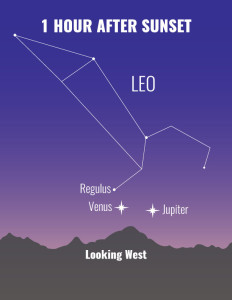By Ashley Oliverio EBS Contributor
Whether you’re a first-time Gallatin Canyon visitor or a lifetime resident, the sight of stars blinking brightly above Big Sky never gets old.
Thanks to dark skies relatively free of artificial lighting, the area offers spectacular celestial views, and with the sun setting earlier each night since the June 21 summer solstice, star-hunting season is open. Currently, the most brilliant stars are actually planets, and Venus, Jupiter and Saturn stand out after sunset.
 Venus and Jupiter are the first and second most luminous orbs, respectively. Approximately 30 minutes after sundown look low in the west to spy Venus, the most stunning “star” in the sky. It glows white to the lower left of Jupiter, our solar system’s largest planet. If high mountains obscure your view to the west, travel to a spot with an unimpeded vista.
Venus and Jupiter are the first and second most luminous orbs, respectively. Approximately 30 minutes after sundown look low in the west to spy Venus, the most stunning “star” in the sky. It glows white to the lower left of Jupiter, our solar system’s largest planet. If high mountains obscure your view to the west, travel to a spot with an unimpeded vista.
The distance between the two planets is currently a mere five degrees, about equal to the width of half your fist held at arm’s length. In the weeks ahead, Venus and Jupiter will pull further apart – they were closest on July 1 – and set earlier, so now is the perfect time to catch them dancing in the dark.
Venus and Jupiter ride just to the west of the constellation Leo – Latin for lion – as the big cat prepares to pounce behind the horizon at nightfall. Shaped like a crouching lion, Leo has a maned head and chest formed by stars in a backward question mark formation, punctuated at the base by Regulus. The word Regulus means “little king,” which is appropriate for the brightest point in this stellar king of beasts.
Venus, once thought to be Earth’s sister, is actually more like our planet’s evil twin. Measuring about 7,500 miles wide, Venus is nearly the same size as Earth and home to mountains and volcanoes.
However, this planet named for the Roman goddess of love is inhospitable. At a sizzling 900 F, the surface of Venus is hot enough to melt lead, and its atmospheric pressure is 90 times greater than Earth’s. The air on Venus is 96 percent carbon dioxide, lethal for humans to breathe, and her thick cloud cover is made from sulfuric acid. An astronaut landing on Venus would be simultaneously poisoned, burned and crushed.
Jupiter, named after the Roman ruler of the gods, is a gaseous giant, a mammoth ball of primarily hydrogen and helium measuring almost 89,000 miles across, or 11 times the diameter of Earth. Jupiter’s mass – or the amount of matter it’s made of – is greater than the combined masses of all our solar system’s planets, moons, comets, asteroids, and meteoroids.
The diminutive Venus outshines Jupiter in our sky because of its proximity to Earth. Currently, Venus is approximately 40 million miles from us, while Jupiter soars over 575 million miles in the distance. Even further than Jupiter, Saturn orbits the sun more than 850 million miles from Earth.
Look for Saturn high to the south about an hour after dusk, and you’ll spy it shining vanilla-white just to the right of a diagonal pattern of three dimmer stars that form the raised claws of the constellation Scorpius the scorpion. Shaped like a fishhook dangling over the southern horizon, Scorpius features in its center the arresting ruddy star Antares, a word meaning “rival of Mars.”
Saturn is a gas giant like Jupiter and reigns as the second largest planet in our solar system. It should glimmer into view soon after Venus and Jupiter appear.
Even a small backyard telescope on a steady mount will reveal Saturn’s famous rings. Unlike Jupiter and Venus, which set just after dark, Saturn is up all night in its steady march westward, giving us hours of enjoyment under the glorious Big Sky.
Ashley Oliverio recently moved to Big Sky and was the former president of the Helena Astronomical Society, and head of public relations and communication for Carroll College. She has more than 20 years of experience as a writer, editor and astronomy columnist for Helena newspapers.












